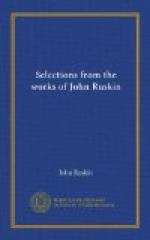[183] As Slade Professor, Ruskin held
a three years’ appointment at
Oxford.
[184] This story comes from Pliny, Natural
History, 35. 36; the
two rival painters alternately showing
their skill by the drawing
of lines of increasing fineness.
[185] This story comes from Vasari’s Lives of the Painters. See Blashfield and Hopkins’s ed. vol. 1, p. 61. Giotto was asked by a messenger of the Pope for a specimen of his work, and sent a perfect circle, drawn free hand.
[186] Timothy vi, 10.
THE RELATION OF ART TO USE
Our subject of inquiry to-day, you will remember, is the mode in which fine art is founded upon, or may contribute to, the practical requirements of human life.
Its offices in this respect are mainly twofold: it gives Form to knowledge, and Grace to utility; that is to say, it makes permanently visible to us things which otherwise could neither be described by our science, nor retained by our memory; and it gives delightfulness and worth to the implements of daily use, and materials of dress, furniture and lodging. In the first of these offices it gives precision and charm to truth; in the second it gives precision and charm to service. For, the moment we make anything useful thoroughly, it is a law of nature that we shall be pleased with ourselves, and with the thing we have made; and become desirous therefore to adorn or complete it, in some dainty way, with finer art expressive of our pleasure.
And the point I wish chiefly to bring before you today is this close and healthy connection of the fine arts with material use; but I must first try briefly to put in clear light the function of art in giving Form to truth.




